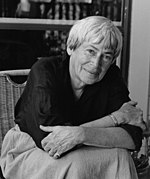
Ursula K. Le Guin
American fantasy and science fiction author (1929-2018)
Sergei Eisenstein was a pioneering Soviet film director and theorist known for his influential silent films like Battleship Potemkin and October. He was a master of the montage technique and has been recognized as one of the greatest filmmakers of all time.
Table of Contents
Sergei Mikhailovich Eisensteinwas a Soviet film director, screenwriter, film editor and film theorist. He was a pioneer in the theory and practice of montage. He is noted in particular for his silent films Strikeand Octoberand Ivan the Terrible (1945/1958). In its 2012 decennial poll, the magazine Sight & Sound named his Battleship Potemkin the 11th-greatest film of all time.
Sergei Eisenstein was a renowned Soviet film director, screenwriter, film editor, and film theorist. He was a pioneer in the theory and practice of film montage and is particularly known for his influential silent films like Strike, Battleship Potemkin, and October.
Sergei Eisenstein’s most renowned films include the silent classics Strike (1925), Battleship Potemkin (1925), and October (1928), as well as the historical epics Alexander Nevsky (1938) and Ivan the Terrible (1945/1958).
Sergei Eisenstein’s Battleship Potemkin was named the 11th-greatest film of all time in a 2012 poll conducted by the magazine Sight & Sound, demonstrating Eisenstein’s enduring legacy and influence in the film industry.
Sergei Eisenstein was a pioneer in the theory and practice of film montage, a technique that involves the strategic editing of shots to create a specific emotional or intellectual effect on the audience. His innovative use of montage significantly shaped the development of modern filmmaking.
Sergei Eisenstein was born on January 22, 1898, in the Russian Empire (now Russia). He was a Soviet film director and theorist who lived from 1898 to 1948, making significant contributions to the art of cinema during his lifetime.
Sergei Eisenstein’s films, particularly his silent classics like Battleship Potemkin, were highly influential and helped shape the development of modern filmmaking. His innovative use of montage and his ability to create powerful, emotionally resonant scenes have cemented his legacy as one of the greatest filmmakers of all time.
The profession of film director can and should be such a high and precious one; that no man aspiring to it can disregard any knowledge that will make him a better film director or human being.
Soviet filmmaker (1898-1948)
Language is much closer to film than painting is.
Soviet filmmaker (1898-1948)
For example, in painting the form arises from abstract elements of line and color, while in cinema the material concreteness of the image within the frame presents – as an element – the greatest difficulty in manipulation.
Soviet filmmaker (1898-1948)
Even in a less exaggerated description, any verbal account of a person is bound to find itself employing an assortment of waterfalls, lightning rods, landscapes, birds, etc.
Soviet filmmaker (1898-1948)
Now why should the cinema follow the forms of theater and painting rather than the methodology of language, which allows wholly new concepts of ideas to arise from the combination of two concrete denotations of two concrete objects?
Soviet filmmaker (1898-1948)